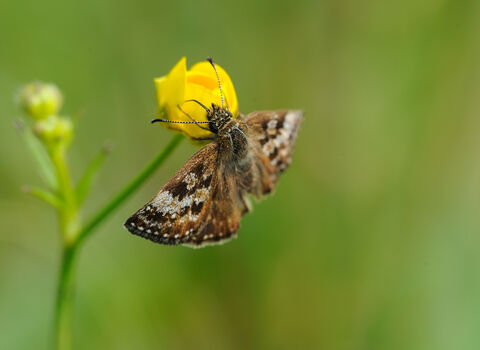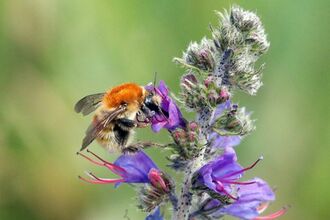Our position
Essex Wildlife Trust remains fundamentally opposed to the proposals for the Arena Essex and Fishing Lake Arterial Road Purfleet-on-Thames development for a Google data centre campus, due to serious impacts (irreversible loss) on rare habitats and nationally important invertebrate species assemblages.
- Summary
1.1 Loss of Arena Essex Local Wildlife Site (LoWS)
- The proposal would destroy ~50% of the Arena Essex LoWS, designated for its Open Mosaic Habitat on Previously Developed Land (OMHPDL), a Priority Habitat.
- Further losses would further fragment Thurrock’s LoWS network, already heavily degraded by recent developments (e.g., Tilbury 2, London Distribution Park, Lower Thames Crossing).
1.2 Irreversible Loss of Priority Habitat (OMHPDL) and TTG Grassland
- Over 80% of the site’s OMHPDL, including rare Thames Terrace Gravel (TTG) grassland, will be lost.
- No geological survey was conducted to assess the TTG strata.
- The ES lacks precise figures or maps detailing the habitat extent or proposed losses.
- The site supports Filago pyramidata, Broad-leaved Cudweed, an endangered species under Schedule 8 of the Wildlife and Countryside Act 1981.
1.3 Impacts on Nationally Important Invertebrate Assemblage
- The Arena Essex site supports a nationally important invertebrate population, with the ES acknowledging its conservation value.
- Priority Species historically recorded include Bombus humilis, Dorycera graminum, Cerceris quinquefasciata, and Erynnis tages. Rare species in 2024 include Mordellistena pseudoparvula, Pelenomus olssoni, and Ortholomus punctipennis.
1.4 Impact on Thames Estuary North Important Invertebrate Area (IIA)
- The site lies within a nationally recognised IIA, which has suffered cumulative brownfield losses exceeding 50%.
- We strongly dispute the ES’s classification of residual impacts as "minor adverse/beneficial", and maintain impacts are nationally significant due to the scale of habitat destruction.
1.5 Inadequate Survey Methodology
- The 2024 invertebrate survey was insufficient:
- Only three visits (May–July), excluding key seasonal activity periods.
- No weather data, no full species list, and erroneous references to an unrelated site ("Silvertown").
- Unedited, full survey data have not been disclosed, compromising transparency.
1.6 Flawed Habitat Assessment Methodology
- The OMHPDL was assessed using novel and unvalidated "condition drivers" and "quality indicators" not recognised by statutory bodies or existing guidance.
- The site-wide habitat value, essential for invertebrate diversity, was inappropriately fragmented into independent parcels.
- OMHPDL extent is underestimated due to failure to include scrub/grassland mosaics.
1.7 Insufficient Mitigation and Absence of Biodiversity Net Gain
- No specific details or quantitative plans are provided for: Habitat loss/retention
- Creation measures
- Biodiversity Net Gain (BNG)
- Proposed measures (e.g., ponds, bee banks, tree planting) are ecologically inadequate or counterproductive.
- Compensation for TTG grassland loss is not addressed.
- No specialist entomological input is evident in the mitigation strategy.
1.8 Policy Non-Compliance
- The development conflicts with:
a. The National Planning Policy Framework (NPPF) paragraph 124 and 192(b)
b. Thurrock Council's Core Strategy (Policies CSTP19 and PMD7)
- No "exceptional circumstances" have been demonstrated to justify the destruction of Priority Habitat and LoWS.
- Discussion
2.1 Arena Essex Local Wildlife Site (LoWS)
The proposed development would result in the loss of approximately half of the Arena Essex Local Wildlife Site (LoWS), which is designated for its Open Mosaic Habitat on Previously Developed Land (OMHPDL) and its nationally important invertebrate assemblage. OMHPDL is a Priority Habitat under Section 41 of the NERC Act 2006. The site is also one of only a few known to support the Endangered Broad-leaved Cudweed (Filago pyramidata), protected under Schedule 8 of the Wildlife and Countryside Act 1981.
The Arena Essex LoWS is one of the largest remaining LoWS in the borough and plays a crucial role in maintaining ecological connectivity and supporting biodiversity across the wider LoWS network. Its degradation and fragmentation will have far-reaching impacts beyond the site boundary. This proposal must be viewed in the context of cumulative habitat losses within Thurrock, where nationally important invertebrate sites have already been significantly eroded by recent development. Further losses would severely undermine the integrity of the LoWS network and are contrary to both national and local biodiversity policies.
2.2 Key strategic importance of LoWS
Arena Essex and the LoWS network in Essex play a crucial role in maintaining the county's ecological health and biodiversity. These sites represent some of the most valuable wildlife habitats outside of statutory protected areas like Sites of Special Scientific Interest (SSSIs).
LoWS are fundamental building blocks of the emerging Local Nature Recovery Network (LNRN) in Essex and require robust protection to fulfil this critical role. The LNRN represents a strategic shift towards landscape-scale conservation, moving beyond protecting isolated nature reserves to creating interconnected networks of habitats. As core areas within the LNRN, LoWS provide essential habitat nodes that can be linked through nature recovery corridors and enhanced buffer zones. The success of the LNRN depends on having sufficient habitat diversity to support the full range of Essex's wildlife throughout their life cycles. Climate change adaptation makes LoWS protection even more urgent within the LNRN framework. As species' ranges shift and extreme weather becomes more frequent, wildlife will increasingly depend on connected networks of high-quality habitats to survive.
The economic argument for protecting LoWS within the emerging LNRN is compelling. These sites already deliver ecosystem services of very significant economic value. Destroying them requires expensive replacement habitat creation and fragments the network connectivity that enhances their individual value. Ensuring robust protection of LoWS through the planning system is invariably more cost-effective than restoration.
2.3 Nationally Important Invertebrate Assemblage
The application site supports a nationally important assemblage of invertebrates, as acknowledged in the Environmental Statement (Ethos Environmental Planning, April 2025). Surveys conducted in 2024 recorded 531 species, 48 of which (over 9%) hold conservation status. While this is lower than the 12% recorded in 2018 (from a larger sample of 628 species), the disparity likely reflects reduced survey effort, limited seasonal coverage, and differing methodologies—not a decline in ecological value. The 2024 surveys confirmed that key habitat features remain in favourable condition and support high-quality invertebrate habitat.
Priority Species recorded in 2018, including the Brown-banded Carder Bee (Bombus humilis), Phoenix Fly (Dorycera graminum), Five-banded Weevil-wasp (Cerceris quinquefasciata), and Dingy Skipper (Erynnis tages), were not detected in 2024, likely due to the omission of key flight periods within the survey protocols. Given the continued presence of suitable habitat, it is appropriate to assume these species remain present. Other significant species recorded include Mordellistena pseudoparvula (Nationally Rare), Pelenomus olssoni, and Ortholomus punctipennis, both of which have very few modern records in Essex. Pantheon analysis identified six Specific Assemblage Types indicating favourable habitat, including ‘bare sand and chalk’ and ‘open short sward’, associated with 237 and 213 species, respectively. This evidences the site’s exceptional value for invertebrate biodiversity and underlines the need for rigorous mitigation and compensation, which the current application fails to provide.
2.4 Invertebrate Surveys
The invertebrate surveys undertaken in 2024 are insufficient to inform a robust ecological assessment of a site recognised as nationally important for invertebrates. Only three survey visits were conducted between 20 May and 11 July—omitting key periods in early spring and late summer—contrary to best practice guidance such as Natural England’s Invertebrate Standard Advice for Essex, which recommends at least six visits across a broader seasonal window. This reduced effort likely contributed to the lower proportion of species of conservation concern recorded in 2024 (9%) compared to 2018 (12%).
Significant concerns also arise from the quality and transparency of the survey report. Key information—such as weather conditions, survey limitations, and a complete species list—is missing. In addition, the inclusion of content referring to a different site (Silvertown, London) undermines the credibility of the assessment, with multiple factual inaccuracies and inconsistencies in species numbers and assemblage types. Without comprehensive and accurate data, the ecological impact of the proposed development on this nationally significant site cannot be properly assessed. Further surveys are therefore required to meet the accepted standard.
2.5 Thames Estuary North Important Invertebrate Area
The majority of the application site lies within the Thames Estuary North Important Invertebrate Area (IIA), a nationally recognised network of high-value habitats essential for invertebrate conservation. These brownfield and OMHPDL sites function as interconnected habitat blocks and stepping stones, critical to the survival of a nationally important invertebrate assemblage.
This development would result in the loss of over 80% of the site’s OMHPDL, further fragmenting this already vulnerable habitat network. This includes areas supporting nationally rare Thames Terrace Gravel (TTG) grassland, which is irreplaceable and extremely limited in extent. Despite its recognised national importance, no clear figures or maps showing the extent of OMHPDL loss are provided in the application.
The Environmental Statement concedes that impacts on OMHPDL will be “major adverse” at a national level, yet the development does not demonstrate any meaningful effort to avoid or reduce harm to these high-value habitats. This failure to apply the mitigation hierarchy or respond to Natural England’s concerns represents a serious deficiency in the application and undermines compliance with national biodiversity legislation and policy.
2.6 Inadequate Mitigation and Overall Net Biodiversity Loss
The application provides wholly inadequate detail on mitigation, habitat creation, and compensation. Habitat loss has not been quantified, and proposed measures—such as pond and bee bank creation—are insufficient to compensate for the scale of loss. Although the Environmental Statement acknowledges a significant residual adverse impact and the need for compensation, no Biodiversity Net Gain (BNG) metric or off-site proposals are included.
The illustrative masterplan shows narrow strips of retained or created habitat around built areas, but these will be shaded and unsuitable for thermophilic invertebrates associated with OMHPDL. Tree planting in
these areas further reduces their ecological value. Crucially, no attempt has been made to retain extensive high-quality habitat on site, and no evidence has been presented that OMHPDL—particularly TTG grassland—can be effectively recreated elsewhere.
The applicant suggests that, without development, the site would naturally succeed and lose its value as OMHPDL. However, this argument is unsubstantiated. The site currently supports flower-rich habitat, bare ground, and short sward vegetation, with dry, nutrient-poor soils that inhibit rapid succession. These features continue to support nationally important invertebrates in the absence of active management.
Succession is a natural process affecting most habitats and should not be used to justify irreversible habitat destruction. With appropriate planning and conservation mechanisms—such as those expected under the forthcoming Essex Local Nature Recovery Strategy—the long-term management and protection of this site remain viable alternatives to development-led loss.
The proposed management strategy for retained and created habitats is fundamentally inadequate. It relies solely on recreational use—namely biking and walking trails—to create disturbance and maintain habitat openness. This approach is unreliable, lacks control, and risks leading to habitat degradation rather than enhancement, particularly without monitoring or adaptive management.
Furthermore, there is no evidence of entomological input into the proposed mitigation strategy. Given the presence of rare and Priority invertebrate species, any successful habitat management and compensation plan must be informed by specialist expertise. In its current form, the application fails to demonstrate that long-term habitat quality or species conservation can be sustained.
- Conclusion
Based on the above points, Essex Wildlife Trust urges Thurrock Council to refuse permission for this planning application.


